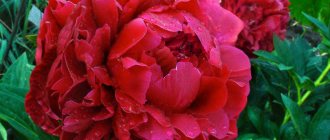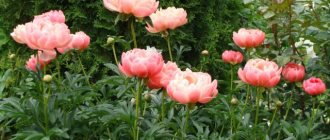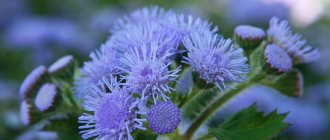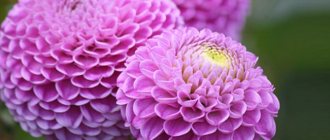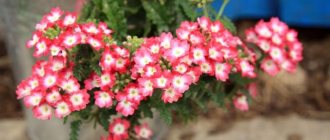History of selection
Paeonia Karl Rosenfield belongs to the herbaceous species. Developed in China, it is sometimes heard referred to as Rosenfield. In its homeland, it gained such popularity that it served as a decoration for the national emblem. Also, images of this peony are often used to decorate fabrics, not only in China, but also in Japan.
Peony Karl Rosenfeld from China has spread throughout the world
Thanks to its spectacular appearance and ease of care, the Karl Rosenfeld variety is loved by flower growers. Moreover, this southern plant feels good in a fairly cool climate. Peony will not be able to take root except in the Far North.
Description of peony Karl Rosenfeld
The bush of the Karl Rosenfeld variety is powerful, reaches a height of 1 m, spreading. The leaves are carved and have a light olive tint.
The leaf plate on the surface is smooth, with a noticeable shine. In autumn, the bush turns red, which allows the Karl Rosenfeld peony to remain decorative all season.
Basically, the plant has gained such popularity due to its lush and bright flowers. The peony will show all its beauty when planted in open sunny places. The shoots and peduncles are quite strong, dense and able to withstand the weight of large buds.
Inflorescences up to 20 cm in diameter, double, brightly colored. Most often you can find Karl Rosenfeld in ruby or purple tones, but there are options with rich red, soft pink and white flowers.
It is not necessary to tie up the bush, but many gardeners use decorative supports because the peony is quite spreading.
The surface of the leaf is smooth, with a visible shine. At the end of summer, the crown acquires a reddish color and remains that way until late autumn.
The advantages of peony Karl Rosenfeld are as follows:
- cold resistance;
- tolerates drought well;
- resistance to most diseases and pests;
- large bright double flowers;
- pleasant aroma;
- ease of care.
The disadvantages include the high cost of these peonies, as well as the loss of varietal characteristics when propagated by seeds.
Varieties most in demand among gardeners
Kiao Sisters
An unpretentious, disease- and frost-resistant variety up to 2 meters high.
The flowers are white and pink with a diameter of up to 25 cm. They bloom for 2 weeks. Kiao sisters in bloom
Kinko's
The petals are bright lemon in color with a pink edge. The diameter of the flowers is 18-20 cm. The plant itself is up to 1 meter in height. It grows well. Suitable for single and group plantings. Resistant to cold and disease. Blooms in May-June.
Blue sapphire
It has large pink-violet flowers with a diameter of up to 25 cm. Peony stems are thin and low, so they are tied up. The plant is unpretentious.
Red giant
Up to 1.5 meters high with red crowned flowers up to 16 cm in size. Blooms in June. Frost-resistant. Feels good in the sun.
Green beans
Up to 90 cm in height with light green double inflorescences with a diameter of 17-20 cm and a weakly expressed aroma. The variety is resistant to disease and frost.
Coral altar
It has pink-coral, toothed, hollow flowers. The aroma is sweetish. Blooms in June for 15 days. Grows in sunny fertile areas.
White wanderer
Up to 1.5 meters high. In mid-June, rich white crown-shaped inflorescences with a diameter of 15 cm are formed on erect stems.
Application in design
The herbaceous peony Karl Rosenfeld is very popular among landscape designers. Bright, beautiful flowers look great in many compositions. But here you need to carefully select your neighbors.
The recommended placement scheme for the Karl Rosenfeld variety is to place 4-5 bushes in the middle of the flower garden, with ground cover crops around them. Peonies look good with hybrid tea roses, which bloom a little later and look great against the background of reddish foliage.
Karl Rosenfeld is also used in the formation of mixborders. In this case, decorative onions, mantles and garden geraniums will be good neighbors. In flower beds, peonies are combined with Siberian iris, sedum and common chinstrap.
Attention! Herbaceous peonies should not be planted with plants of the Ranunculaceae family, as they deplete the soil and will not allow large flowers to bloom normally.
When placing the Karl Rosenfeld variety in the composition, it is worth considering its main properties:
- it is a bright spot that attracts attention;
- requires open sunny areas and fertile soil;
- can grow in one place for 15 years;
- a spreading bush requires enough space.
Karl Rosenfeld is one of the main accents of any composition, regardless of its neighbors.
With the correct selection and proper placement of plants, you can get a flower bed that blooms from early summer until the last days of autumn.
Peony Rosea Plena (Paeonia Rosea Plena) - what kind of variety is it, history of creation
Herbaceous perennial. Has medicinal properties. Height up to 100 cm. Single large flowers can be double, semi-double or simple. The diameter of the flowers reaches 15 cm. The color of the petals is pink. Large, dark green, heavily dissected leaves.
Peony Rosea Plena – highly decorative and beautiful
Brief description, characteristics
The powerful fleshy root tubers of the peony are located quite deep in the soil, so the plant easily tolerates frosts down to -40 ºС without additional insulation.
Flowering is friendly and short-lived. At the same time, up to 20 silk flowers with a delicate aroma can be open on the bush.
Advantages and disadvantages of the variety
Like any other, the peony Officinalis Rosi Plena has its own characteristics.
Advantages:
- friendly flowering;
- highly decorative;
- frost resistance;
- does not require frequent transplantation;
- unpretentiousness.
Flaws:
fades quickly.
Use in landscape design
Peony Officinalis Rosea plena is planted:
- in groups with other varieties of peonies;
- in prefabricated compositions;
- as tapeworms.
The blooming herbaceous peony Rosi Plena is beautiful on its own, and after flowering has finished, its rich greenery serves as an excellent background for other flowers.
Peony on the site as a decorative design for the garden
Reproduction methods
Peony Karl Rosenfeld can be propagated in two ways:
- Dividing the bush.
- Seeds.
The second method is quite labor-intensive, and flowering can only be expected in the 4th-5th year, and there is no guarantee that the varietal characteristics will be preserved.
Dividing the bush is the simplest and most effective propagation method. Flowering can be observed already from the second year, after planting. It is recommended to divide an adult bush at the end of August. Each part must contain at least three buds, from which flower stalks and an intact tuber will appear. To protect the cut site, it is treated with ash or brilliant green.
Preparation of planting material
Both seeds and cuttings can be used as planting material. But there is an unreasonable amount of trouble with the seeds, and such a plant will bloom only in five years. Therefore, the best option is to plant cuttings. An adult bush, the age of which varies from 8 to 10 years, needs to be divided into parts along with the roots. Each such part is a finished piece. You need to make sure that there are no more than 3-5 buds on it. Since the roots are damaged by division, they will not be able to provide nutrition to a larger number of buds, and as a result, the bush will develop poorly, be sick and look unsightly.
The length of the roots should be about 15–17 cm, the excess should be cut off. To treat cuts, you should make a mixture of wood ash and any fungicide. After application, it will protect the roots from various unpleasant diseases and also prevent rotting. The cuttings prepared in this way can be planted in open ground.
This is interesting: When to replant peonies - choosing a new location, timing and rules
Planting and care
For successful cultivation and full flowering, the lactiferous peony Karl Rosenfeld requires the fulfillment of certain conditions:
- Illumination - you need to choose an open place and make sure that there is access to the sun's rays, but protection from drafts and strong winds is important.
- Soil - loamy or sandy loam soils are ideal. It is worth considering that flowers will appear earlier on sandy substrates, but their decorative qualities will be worse.
- Humidity - the main thing is to ensure good drainage and avoid stagnation of water. In soils prone to waterlogging, when planting in lowlands, the roots will most likely begin to rot.
Peonies are planted by Karl Rosenfeld in the last days of August or the very beginning of September. Planting dates directly depend on the weather conditions of the growing region. In cold climates, peonies are planted in the third ten days of August, in the middle zone - in early September, and in the south - in the first ten days of October.
Before planting, the tubers are kept in a solution of potassium permanganate, then the existing sections are treated with ash.
Seedlings must be selected that are strong and without external damage. The tubers should be quite dense. You need to make sure that there are at least four buds, then flowering will be early. Long roots are cut to approximately 15 cm.
Algorithm for planting herbaceous peony Karl Rosenfeld:
- Make a hole measuring 50x50 cm.
- At the bottom there is a drainage layer and nutrient soil.
- Compost, ash and superphosphate are added to poor soil.
- The roots of the tuber are straightened and distributed along the bottom of the hole.
- Next, the plantings are covered with earth, each layer must be compacted.
- Then water and mulch the soil.
- If there are several bushes, maintain a distance of 1 m between them.
- The flower bud is buried 4-5 cm.
Important! The herbaceous peony is not suitable for placement in flowerpots or in an apartment due to its considerable size.
How to properly plant and grow a flower in open ground
The herbaceous peony Raspberry Sundae is unpretentious to growing conditions. How well it will take root after planting and how soon it will begin to bloom largely depends on the correctness of the procedure.
Planting with root cuttings
The root division method or root cuttings is the most common method of propagating peonies. The procedure is quite simple and boils down to separating sprouts with single buds and their own roots from the root system of the mother bush.
Note! Adult peony bushes aged 3-5 years are the easiest to tolerate the division procedure.
What time does boarding take place?
The procedure for separating cuttings is carried out at the very end of August or at the beginning of September. Later dates are undesirable, since the plant will not have time to adapt to the new location and may die from the first frosts. In spring, the buds actively grow, so a spring transplant will greatly harm the mother bush.
Selecting a location
For the heat-loving peony Raspberry Sandae, it is advisable to choose a sunny area with well-drained soil. The acidity of the soil at the site where the plant is planted should be neutral.
How to prepare the soil and flower for planting
If the soil in the selected location is not loose and light enough, then river sand is added to it. To saturate the soil with nutrients, it is recommended to add peat or humus. The above-ground part of the division to be transplanted is almost completely cut off, and the root sections are dipped in wood ash.
Step by step landing procedure
Planting Raspberry Sunday is carried out in compliance with the rules that apply to all herbaceous peonies. You must proceed as follows:
Dig a hole 2 shovels deep and 50-60cm wide. The bottom is well drained with fine crushed stone. Fill the hole with a fertile soil mixture consisting of equal amounts of peat, humus, turf soil and sand. In the center of the filled hole, make a small hole with your hands, in the center of which place the root cutting. Sprinkle the roots of the cuttings with soil and compact it with your hands.
At the same time, it is important that the buds do not rise above the soil level above 3 cm. After planting is completed, the bush is carefully watered and the space around it is mulched with sawdust
After planting is completed, the bush is carefully watered and the space around it is mulched with sawdust.
Planting by seeds
Sowing peonies with seeds is quite a troublesome task, since the seed material has a low germination rate. It will be possible to evaluate the result only after 5 years, when the new plant comes into force and begins to fully bloom. This method of reproduction is used for the purpose of selection.
Note! Seedlings of a pollinated plant often sprout into seedlings that have lost their varietal qualities.
Features of cultivation
Subsequent care for peony is simple:
- Watering is carried out regularly and abundantly at the rate of one bucket of water per bush. On dry days, water the plant once a week. With a lack of water, the flowers will be small and lose their attractive appearance.
- In order for the soil to be saturated with oxygen, it is necessary to loosen and mulch. Hay or sawdust retains moisture well, prevents the growth of weeds and at the same time serves as an organic fertilizer.
- Pruning is necessary to maintain a decorative appearance. Old wilted flowers are removed, thus allowing new buds to open fully.
- More complete pruning is carried out 30-40 days before the onset of the first frost. All shoots are brought to a height of 20 cm.
With proper agricultural technology and timely feeding, the Karl Rosenfeld peony will please the eye for 20 years. For the season after planting, it is necessary to apply fertilizers according to a certain scheme:
- April - fertilizing with nitrogen;
- during the formation of buds - organic fertilizers;
- as soon as the peonies fade - a mineral complex;
- at the beginning of autumn - this is the time when flower buds for the next year are laid, it is important to add humus and superphosphate.
Content nuances
To grow such a peony in your dacha, you need to know the following nuances of its contents:
- The place of growth should be sunny and moderately warm. Drafts should not be allowed;
- When planting seedlings, you need to ensure that the recovery bud is at a level of 3–5 cm from the existing soil level. If you deviate, flowering will not occur;
- the optimal soil for planting is fresh and moderately dry, rich in micro- and macronutrients;
- watering is carried out regularly as the top layer of soil dries;
- fertilizing is applied in early spring, before the start of the growing season. During the period of active growth and budding, mineral fertilizers should be used. In the second half of the season, organic matter must be used to feed the bushes;
- the most dangerous parasites for a peony of this variety will be ants. They slow down flowering and are capable of infecting the plant with pathogenic microflora. Therefore, plantings must be periodically sprayed with protective solutions;
- wintering in the middle zone is carried out without wrapping and additional shelters.
As you can see, the Karl Rosenfield peony is an unpretentious variety in terms of cultivation that will become a worthy decoration for any garden.
Protection from diseases and pests
The main enemy of peonies is the ant. These insects live in huge colonies and parasitize plants, sucking the juice from them. Ants especially like the buds with their sweet nectar. Insects are also dangerous as carriers of various diseases. You can fight ants using repellents.
A colony of ants can destroy even strong peony bushes
Peony Karl Rosenfeld is resistant to many diseases if the plantings are not thickened and the watering regime is maintained. If these rules are not followed, the following ailments can be found on plants:
- Gray rot - leaves and stems suddenly wither, buds turn black and do not develop. The petals dry out at the edges and turn brown. The peak incidence occurs in the spring. Infected parts of the plant are removed and burned, and the entire bush is treated with a fungicide.
Gray rot most often appears when plantings are very dense - Cladosporiosis - manifests itself in the form of brown or purple spots on peony leaves. Over time, these spots increase in size until the entire surface becomes affected. On the back of the leaf you can see a smoky coating of spores. Overwinters on fallen leaves. Copper preparations help well against cladosporiosis.
Cladosporiosis overwinters on plant debris, which is why it is so important to promptly clear the soil of debris.
